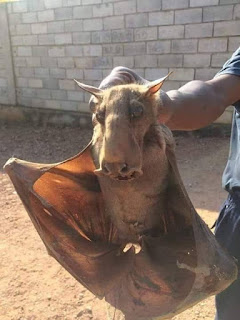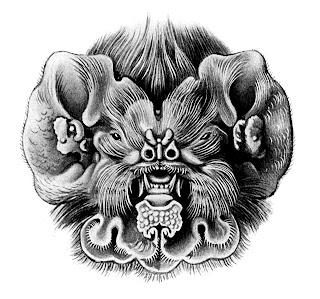Photograph
of hammer-headed bat currently doing the online rounds on social media (© owner
presently unknown to me – reproduced here in a strictly non-commercial Fair Use
basis for educational, review purposes only)
During the past
couple of days, several internet friends and colleagues have independently
brought the above photograph to my attention, asking me whether the creature
portrayed in it is real or photoshopped. I can confirm that it is indeed real –
it is a specimen of tropical Africa's hammer-headed
bat – but due to the optical illusion of forced perspective, i.e. caused by it
being positioned much closer to the camera than is the person holding it, this
very distinctive-looking bat appears much bigger than it really is.
Nevertheless,
seeing this photograph reminds me of what may be some genuinely giant mystery
bats, and regarding one of which the hammer-headed bat has indeed been
considered as a possible explanation – so here they are.
Taxiderm
specimen of a hammer-headed bat (© Dr Karl Shuker)
Native to New Guinea and the Bismark
Archipelago, the world's largest known species of modern-day bat is the Bismark
fruit bat Pteropus neohibernicus, which sports an extremely impressive wingspan
of up to approximately 5.5 ft, and there are
several other fruit bat species with sizeable spans too. Moreover, quoting from
the third (most recent) edition of the late Gerald L. Wood's still-invaluable
source of animal superlatives The Guinness Book of Animal Facts and Feats:
According
to Peterson (1964)* a huge example of P. neohibernicus from New Guinea
preserved in the American Museum of Natural History, New York, has a head and
body length of 455 mm 17.9 in and a span of 1.65 m 5 ft 5 in. He thinks that some unmeasured specimens may
reach 183 m 6 ft, but this figure is unconfirmed.
*Peterson (1964) = Russell F. Peterson,
Silently, By Night (McGraw-Hill: New York, 1964), an authoritative book
on the natural history of bats, a copy of which I own.
However, the
cryptozoological chronicles contain details concerning at least two types of
giant mystery bats whose wingspan is claimed to be twice as big as the above!
Famous
vintage photo of a fruit bat (species unnamed) with a very impressive wingspan
(originally © Otto Webb, now public domain? – reproduced here on a strictly
non-commercial, Fair Use basis for educational, review purposes only)
The secluded
river valleys of western Java in Indonesia are reputedly
home to one of these - an enormous but very elusive bat known to the local
people as the ahool. It derives its name from the sound of its unmistakeable
cry, which it is said to utter three times in succession while on the wing at
night.
When questioned
by interested Westerners, the locals provide consistent descriptions of the
ahool. It has a monkey-like head and flattened humanoid face, a body as big as
a one-year-old child's, and a massive 12-ft wingspan. It feeds principally upon
large fishes that it snatches from underneath stones on river beds, but is
occasionally encountered crouching on the forest floor, whereupon its feet are
said to point backward. This last-mentioned feature may initially sound bizarre
and implausible, but in reality it actually provides support for believing the
remainder of their description, because as bat experts will readily testify,
bats' feet do point backwards. Even when hanging upside-down from a branch, a
bat wraps its feet around the rear portion of the branch, with its feet curling
towards the observer, instead of away from him.
Does
a giant bat, or bat-like cryptid, still awaiting scientific discovery explain
reports of the ahool? (© Dr Karl Shuker)
One of the most
interesting encounters with an ahool comes not from an eyewitness but rather an
'earwitness' (whose testimony was first documented by American cryptozoologist
Ivan T. Sanderson in a number of publications). The son of an eminent
zoologist, naturalist Dr Ernst Bartels had spent much of his early life in
Java, and was well-acquainted with the cries of all of the island's fauna. He
was also familiar with the local Sundanese testimony concerning the ahool, but
had remained sceptical – until one evening in 1927.
At around 11.30 pm, Dr Bartels had been lying awake in bed
inside his thatched house near western Java's Tjidjenkol River, listening to
the nocturnal insects' incessant orchestra of noises, when suddenly, from
directly overhead, he heard a single loud, clear cry – "A-hool!". A
few moments later, he heard it again, but further away now. Immediately, he
jumped out of bed, grabbed his torch, and raced outside in the direction of the
cry, whereupon he heard it again, for a third and final time, floating back to
him from a considerable distance downstream. He stood there, totally
transfixed, not because he didn't know what had made this unique triple cry,
but rather because he did!
An olitiau encounter (© William M. Rebsamen)
A mystery bat of
equally dramatic dimensions has also been encountered in Cameroon, West Africa, and by two
very experienced scientific observer, as now described here.
While participating in the famous Percy
Sladen Expedition of 1932, the afore-mentioned Ivan T. Sanderson and fellow
animal-collector Gerald Russell had been wading down a stream in Cameroon's
Assumbo Mountains one evening in search of tortoises to collect when abruptly a
jet-black creature with enormous wings and a flattened monkey-like face flew
out of the darkness and directly towards Sanderson, its lower jaw hanging down,
revealing an abundance of large white teeth.
Sanderson
instinctively ducked, then he and Russell fired a number of shots in the
direction of this terrifying apparition, but it merely wheeled out of range and
vanished back into the darkness, its wings cutting through the still air with a
loud hissing sound. The two men agreed that its wingspan was at least 12 ft, and it seemed to have been jet-black in colour.
When they told
the local hunters back at their camp what had happened, the hunters were all terrified
– so much so that after informing the naturalists that their would-be attacker
was known as the olitiau, they all fled from the camp!
Exquisite
19th-Century engraving of the hammer-headed bat (public domain)
Sceptics later
sought to identify the olitiau as a grotesque species of fruit bat known as the
hammer-headed bat Hypsignathus monstrosus. As its name reveals, however,
the head and face of this species is extremely long and swollen – wholly
dissimilar from the flattened, monkey-like face specifically described by
Sanderson and Russell.
A giant bat-like
entity has also been reported from Ghana, where it is
known as the sasabonsam. In 1939, a report of a
dead specimen was published in the West African Review journal, together
with a photograph of an alleged carving of one such beast, which depicted it
with relatively short wings and a bearded, humanoid face.
Sketch
based upon the above-mentioned photograph of an alleged carving of a sasabonsam
(© Dr Karl Shuker)
There are two
suborders of bats – the mega-bats (constituting the fruit bats), which include
most of the largest species; and the micro-bats (constituting all of the other
bats), many of which are much smaller. Consequently, we might expect bats with 12-ft wingspans to be more closely allied to the mega-bats than to the
micro-bats. In reality, however, the reverse may well be true.
The flattened
monkey or humanoid face of the ahool and the olitiau is particularly
interesting, because this is very different from the long-muzzled, distinctly
fox-like faces of the fruit bats (hence their alternative name of flying fox),
but similar to those of many micro-bats. How extraordinary and zoologically
iconoclastic it would be if the world's largest bat species ultimately proved
not to be mega-bats but micro-bats!
The
flap-ornamented but still unequivocally flat face of a micro-bat – namely, the Antillean
ghost-faced bat Mormoops blainvillii (public domain)
Finally: several
striking photographs of people holding seemingly enormous bats via their outstretched
wings can be readily accessed on the internet. However, close examination of
these reveals that in each instance the bat – invariably a fruit bat, some
species of which are already fairly large – is being held much closer to the
camera than the person who is holding it. As with the hammer-headed bat
photograph opening this ShukerNature article, these images are merely clever
examples of forced perspective.
So, sadly, if we
want to discover a bona fide giant bat, we must look for it not online but
rather in the riverside jungles of Africa, or listen out
for its unique triple cry amid the shadowy forests of Java.
A selection of sourceless online
photographs of supposedly giant bats that in reality are nothing more than
examples of forced perspective (© owners presently unknown
to me – reproduced here on a strictly non-commercial Fair Use basis for
educational, review purposes only)
For more
information concerning the ahool, olitiau, sasabonsam, and other crypto-bats,
be sure to check out my book The Beasts That Hide
From Man.




































Are there any sources for either of these cryptids that do not derive from Sanderson?
ReplyDeleteGood comment. Dr Bernard Heuvelmans gives additional reports of African examples in various of his writings, and I've read fairly general accounts of giant Asian bats, but Sanderson was certainly the person responsible for bringing such cryptids to popular attention, so we have to bear in mind therefore that his versions may contain embellishments, something that he was known for adding to his writings, sadly.
DeleteLooking at this bat reminded me of sci fi movie called Life Force by Tobe Hooper. The Aliens were giant bats that looked much like the Hammer Head. The twist was that these creatures were the source of the vampires of myth and visited earth at regular periods, hiding in the tail of Halley's Comet. Interesting movie!
ReplyDeleteInteresting article too Karl, thanks.
Thanks Martin - I'd never heard of this movie before, I'll have to look out for it, sounds very interesting.
DeleteI can't be the only person who instantly thought "this must be the truth behind the myth of the Jersey Devil" when I saw the horse-shoe bat.
ReplyDeleteThe problem is that its habitat is so far away from North America and that I'm not sure if it ever was kept in captivity anywhere in the Northeastern US...
A number of bat cryptids that are also described as human or monkey-like might be undiscovered relatives of the monkey-faced bats of Melanesia.
ReplyDeletethere will be cryptids in indonesia that have inspired the wildlife of the skull island in the King Kong movie of the 1930s, since in that film the isla calavera is located in indonesia.
ReplyDeleteMmm, very interesting Karl, I had a giant bat encounter when visiting a Brazil and travelling with some friend.
ReplyDeleteIt was hanging/clinging on the very top of a cliff ‘face’ protrusion (at the very top of a large canyon wall) . . . the really odd thing was there were a few of us there and the atmosphere behaviour of everyone was exceptionally odd/suppressed . . .
I suspect that because it was in a bats normal sleeping state (i.e. it was sleeping and then if we’d not been in the odd state we’d have got very close to it AND taken photo’s of it too . . . anyway I’ve written about this here: https://www.realitywalker.com/weird-odd-paranormal-parapsychology-experiences/the-giant-bat-encounter-weird-atmosphere-no-one-speaking-day/
I was wondering Karl, if you have any experience of people being put into a weird 'disengaged' state when encountering weird/not normal 'creatures/phenomenon' because some of few people that left a comment on that page also mentioned 'put off' effects too?